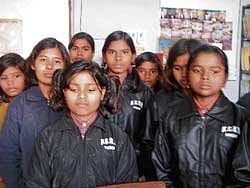

Divya has a dream. Says this 12-year-old student of Class 8, now studying hard to get promoted to Class 9, “I want to study more. My dream is to become a teacher when I grow up and educate the children of my village.”
Her elder sister, Meeta, isn’t as lucky. Meeta stays at home because she has to cook for the family when their mother goes out to work. The girls lost their father, Ram Prasad, about two years ago, after he committed suicide because he was unable to pay back a loan of around Rs 45,000.
The one spark of hope for the family lies in Divya, who has been a student at the Kasturba Gandhi Balika Vidyalay (KGBV), a residential school functioning from a small section of a government school in Sarosa Bharosa village of Kakori block in Lucknow district in Uttar Pradesh.
Educate to empower
KGBVs are residential schools started by the Government of India in 2004-05, providing education from Class 6 to Class 8, especially for girls belonging to marginalised communities under the Sarva Shiksha Abhiyan (Education for All) project.
UP today has 454 such schools, some of them in the most remote and backward areas of the state. Over 80 per cent of these girls are from SC/ST families living much below the poverty line. Each school houses 100 girls and there are more than 39,000 girls in the state are studying in them. The present infrastructure for these schools is very poor but Lalita Pradeep, State Project Officer, Sarva Shiksha Abhiyan, UP, hopes this will change.
The biggest challenge these schools have to face is poor power supply in a state where there is only one power connection for a population of 21, as against an all-India average of one connection for every 9.5 persons.
So bad is the situation in terms of proper lighting that even during lunch, which is served at the school corridor, the girls sit in darkness.
Vijay Laxmi, the crafts teacher at the KGBV school in which Divya is studying, says: “The girls also often keep the windows shut, especially during educational programmes on health or during cultural activities, so that the boys from the adjoining areas can’t peep in.”
The most unfortunate aspectis that the girls cannot study after sunset, so there is no homework and no studying after school hours, according to Shuchi Mittal, the school warden.
Dispelling darkness
It is to help change this reality that a project, sponsored by IKEA, a Swedish company dealing with lighting and interior décor products, through UNICEF. The company will make available 60,000 solar lamps, known as ‘Sunnan’, or ‘bright sun’ in Swedish, to the state of Uttar Pradesh.
Angela Walker, Chief Communication Specialist, UNICEF India, believes that these solar lamps “will help children, especially girls, to play, read, write and study at night”.
She points out that the objective behind these lamps is to ensure that girls who want to study, don’t have to depend anymore on an erratic power supply, in order to do so.
According to the project plan, in the first phase 12,000 lamps will be distributed in 454 KGBVs so that a group of four girls gets one lamp.
The lamps that go to India and Pakistan are equipped with sturdier batteries so that they can perform in very high temperatures and are long-lasting.
They are expected to change the ways in which KGBVs have functioned until now. “So far, all the evening activities are based on oral exercises since there is no electricity at night. Now, the girls would be able to study or do any creative work after sunset. In such a situation, even one solar lamp among four girls would have a major impact on recreational as well as academic activities,” says warden Shuchi Mittal.
Tackling dropout rates
This is potentially a big step forward since, invariably, as girls get older, they drop out of school.
In its Annual Status of Education Report, 2009, Pratham pointed out that while 9.5 per cent of girls in the age group of 11-14 are out of school, the number jumps to 23.5 in the age group of 15-16. UP government records confirm this trend: From Class 1-Class 5, only 10 per cent of children drop out. From Class 6 to Class 8, the figure goes up to 34 per cent.
The new solar lamps may just help shine the light on the benefits of such education. And if that happens more KGBV students like Divya can continue working towards realising their dreams.